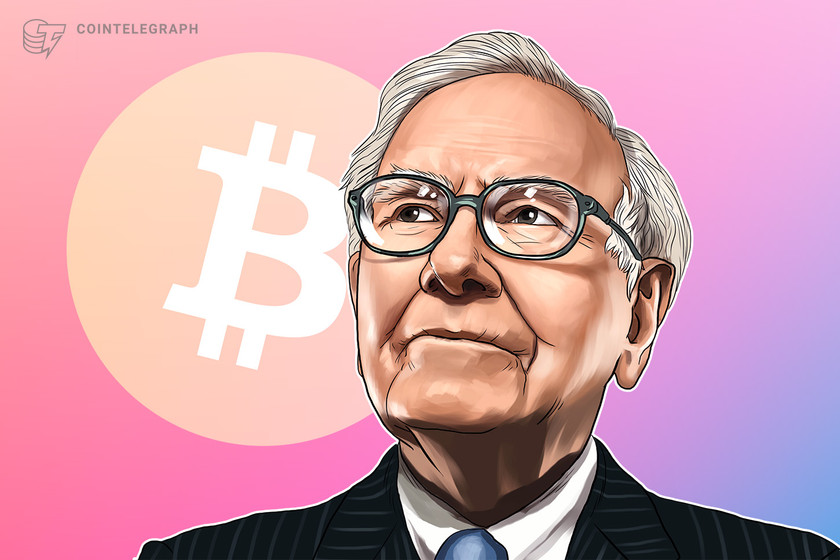Warren Buffett pivots to US Treasurys — A bad omen for Bitcoin price?

Berkshire Hathaway now allocates 60% of its cash portfolio to T-bills, leaving individual investors with the potential to mirror the strategy.
Warren Buffett has put most of Berkshire Hathaway’s cash in short-term United States Treasury bills, now that they offer as much as 3.27% in yields. But while the news does not concern Bitcoin (BTC) directly, it may still be a clue to the downside potential for its price in the short term.
Berkshire Hathaway seeks safety in T-bills
Treasury bills, or T-bills, are U.S. government-backed securities that mature in less than a year. Investors prefer them over money-market funds and certificates of deposit because of their tax benefits.
Related: Stablecoin issuers hold more US debt than Berkshire Hathaway: Report
Berkshire’s net cash position was $105 billion as of June 30, out of which $75 billion, or 60%, was held in T-bills, up from $58.53 billion at the beginning of 2022 out of its $144 billion total cash reserves.
The move is likely a response to bond yields jumping massively since August 2021 in the wake of the Federal Reserve’s hawkish policies aimed at curbing inflation, which was running at 8.4% in July.
For instance, the three-month U.S. T-bill returned a 2.8% yield on Aug. 22 compared with a near-zero yield a year ago. Similarly, the yield on the U.S. one-year T-bill climbed from zero to 3.35% in the same period.

Meanwhile, non-yielding assets like gold and Bitcoin have dropped roughly by 2.5% and 57%, respectively, since August 2021. The U.S. stock market benchmark S&P 500 likewise saw a decline, losing nearly 7.5% in the same period.
Related: BTC to lose $21K despite miners’ capitulation exit? 5 things to know in Bitcoin this week
Such a difference in performance presents T-bills as an ultra-safe alternative for investors compared with gold, Bitcoin and stocks. Buffett’s T-bill strategy suggests the same, namely a bet on more downside for risk-on assets in the near term — particularly as the Fed gears up for more rate hikes.
“Buffett is a value investor, so he won’t allocate much when the equity markets are as overvalued as they have been for the last five years,” Charles Edwards, founder of quantitative crypto fund Capriole Investments, told Cointelegraph.
Meanwhile, Andrew Bary, an associate editor at Barron’s, underscored the market’s potential to tail Buffett’s strategy, saying:
“Individual investors may want to consider following Buffett’s lead now that they are yielding as much as 3%.”
Bitcoin: Safe haven or risk-on?
The risks of positive-yielding debts are dampening the demand for other potential safe havens, Bitcoin included. In other words, increasingly risk-averse investors could be opting for assets that offer fixed yields over those that don’t.
The performance of Bitcoin-focused investment funds in August supports this argument, with capital outflows for three weeks in a row, including a $15.3 million exit in the week ending Aug. 19.
Overall, these funds have lost $44.7 million on a month-to-date basis, according to CoinShares’ weekly report. In total, digital asset investment products, including BTC, have witnessed month-to-date outflows totaling $22.2 million.

Does that mean Bitcoin will continue to lose its sheen against positive-yielding U.S. government debts? Edwards disagrees.
“Allocation to Treasurys and other low-yield cash products is really a decision that needs to be made case-by-case depending on an individual’s goals and risk appetite,” he explained, adding:
“In the short-term, there are times it makes sense to hedge against Bitcoin’s volatility with cash, the best cash being the U.S. dollar. But in the long term, I think all fiat currencies tend toward zero against Bitcoin.”
Edwards also pointed out that Buffett’s long-term strategy remains largely risk-on. Notably, Berkshire deployed 34% of its cash holdings to buy equities in May, and over 70% of its portfolio is still made up of risk-on assets.
“Looking at Buffett’s 75% risk allocation and knowing that Bitcoin has been the best-performing asset of all asset classes in the last decade, having the highest risk-adjusted returns, I know where I would be putting my money,” he added.
Buffett’s portfolio, however, will likely continue to eschew direct BTC investment, as the “Oracle of Omaha” remains a fierce critic. In February 2020, he said that it “does not create anything,” adding:
“I don’t own any cryptocurrency. I never will. […] You can’t do anything with it except sell it to somebody else.”
Earlier this year, however, Buffett’s Berkshire Hathaway increased itsexposure to a Bitcoin-friendly neobank while reducing its stake in Visa and Mastercard.
The views and opinions expressed here are solely those of the author and do not necessarily reflect the views of Cointelegraph.com. Every investment and trading move involves risk, you should conduct your own research when making a decision.



